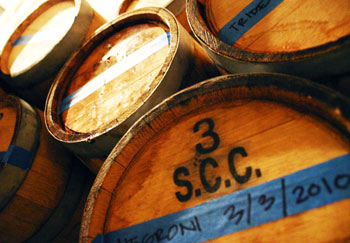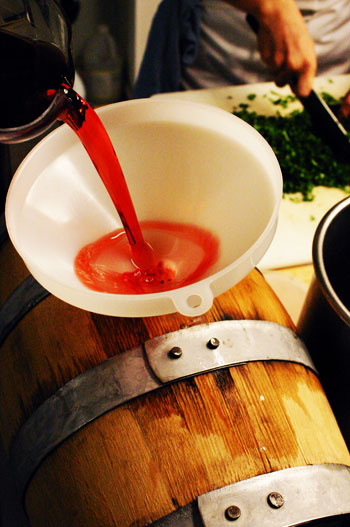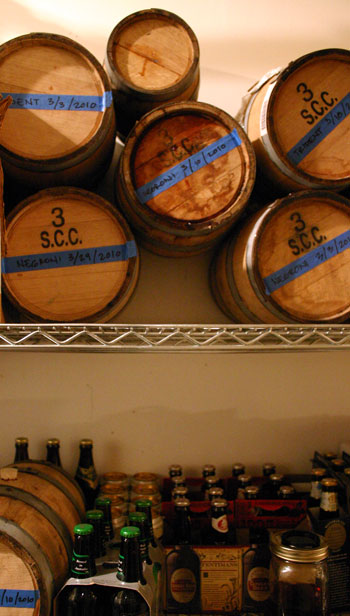Trevor Easter shared this article with me and went and purchased two barrels for us to try and see how this actually works. Trevor and I choose to make a Manhattan and it is now sitting on our front bar aging to perfection. We make sure to take a taste once a week just to track it's progress and it is amazing how much the wood effects the cocktail. Each week the cocktail gains depth and a great smooth texture to it. We are about four weeks from pouring it out of the barrel and bottling it. We will post a blog about our discoveries after all is said and done. I wanted to post this so others could try and share with us their findings. Thanks to Jeffrey for sharing this cocktail idea, it's working out great so far!
"Barrel Aged Cocktails
Wednesday, April 14th, 2010
Permalink

"Inspired by a visit to see Tony Conigliaro at the unnamed bar at 69 Colebrooke Row in London last fall, where Manhattans are aged in glass vessels to sublime and subtle effect, the barrel aged cocktails I’ve been serving at Clyde Common this year are a decidedly American curiosity.
The rub of aging cocktails in a glass bottle is that the whole premise is built upon subtlety, as we know that spirits aged in glass or steel do so at an unremarkable pace. Being from the United States, where – as everyone is aware – bigger equals better, I pondered the following question: what if you could prepare a large batch of a single, spirit-driven cocktail and age it in a used oak barrel?

A hundred some-odd dollars in liquor later, I was nervously pouring a gallon of pre-batched rye Manhattans into a small, used oak cask whose previous contents were a gallon Madeira wine. I plugged the barrel and sat back in anxious anticipation; if the experiment was a success I’d have a delicious cocktail to share at the bar – if it was a failure then I’d be pouring the restaurant’s money down the floor drain.
Over the next several weeks I popped open the barrel to test my little concoction until I stumbled upon the magic mark at five-to-six weeks. And there it was, lying beautifully on the the finish: a soft blend of oak, wine, caramel and char. That first batch sold out in a matter of days and I was left with a compelling need to push the process even further.
Barrels

I’ve been ordering my used whiskey barrels from Tuthilltown Spirits in Gardiner, New York. They sell a three-gallon charred oak barrel that previously held their lovely whiskey, for around only $75.
Now, three gallons of Negroni might not be practical for the home enthusiast, but the average bar or restaurant should be able to afford that sort of quantity quite easily. For those of you trying this at home, try searching the internet for one-gallon charred oak casks (stay away from the fancy lacquered kind meant for display in dens and 1980s wine bars) and be sure to let us know what you find in the comments section below.
Negronis are now prepared in five-gallon batches and poured into multiple bourbon barrels. Robert Hess’ ubiquitous Trident cocktail is currently resting inside single-malt barrels. The El Presidente (à la Matt Robold), Deshlers, Remember the Maines, they’re all receiving the oaked treatment in a little storage room in the basement of the restaurant that I refer to as my “office”.

Once the cocktail is aged long enough for my taste, I then drain the bottle, straining out any charred bits of wood, and bottle the contents for use by my bartenders. To order, the cocktail is then measured out and poured over ice in a mixing glass, stirred, strained into a cocktail glass, and then garnished with the appropriate garnish. It’s quick and simple, as all of the real work has already been done by the barrel.
Anyway, on to the recipes. As simple as it seems to do, I figured not everyone is going to want to do the math to get started on some of these recipes, so here are a few I’ve figured out:
Negroni
Makes Three Gallons
128 oz (approximately five 750ml bottles) dry gin128 oz sweet vermouth
128 oz Campari
Stir ingredients together (without ice) and pour into a three-gallon oak barrel. Let rest for five to seven weeks and pour into glass bottles until ready to serve.
Manhattan
Makes Three Gallons
256 oz (approximately ten 750ml bottles) rye whiskey128 oz (approximately five 750ml bottles) sweet vermouth
7 oz Angostura bitters
Stir ingredients together (without ice) and pour into a three-gallon oak barrel (I prefer a barrel that has previously stored sherry, Madeira, or port wine). Let rest for five to seven weeks and pour into glass bottles until ready to serve.
Trident
Makes Three Gallons
128 oz (approximately five 750ml bottles) aquavit128 oz dry sherry
128 oz Cynar
7 oz peach bitters
Stir ingredients together (without ice) and pour into a three-gallon oak barrel (I prefer a used single malt barrel). Let rest for five to seven weeks and pour into glass bottles until ready to serve."

No comments:
Post a Comment